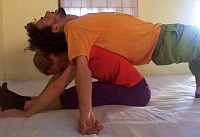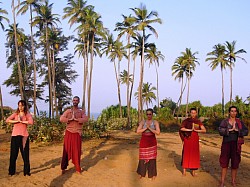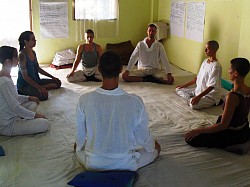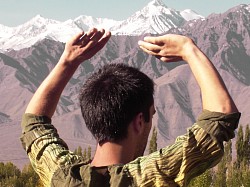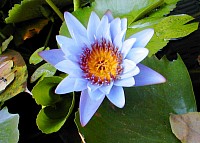Body-Mind Cultivation Practices
Daoist Lifestyle
A healthy and balanced person
is a better and happier therapist.
Promoting physical and mental health
through the ancient practice of
generating balance & harmony
energizing, preserving & maintaining
a lasting sense of well-being.
Proper instruction and constant practice
give results and become part of the daily routine.
On this page - a brief description of ...
- Qi Gong
- Do-In
- Yoga
- Meditation
- Health Benefits
- General information
Qi Gong - 'Life Energy Cultivation'
- an ancient Chinese martial art with more than 4,000 years of history, based on the philosophies of Daoism & Traditional Chinese Medicine (TCM).
In Chinese 氣功
(Qi Gong - Chi Kung - Chi Gung - Ch'i Kung)
'Qi' 氣 can mean - 'vital energy', 'vital substance', 'life energy' ,'breath';
'Gong' 功 can mean 'movement', 'cultivation', 'work'.
'Qi Gong' means - spiritual, mental & physical exercises with and for life energy
The guiding principle - is harmony and balance.
Personal willpower - is the active force.
Externally - Qi Gong is expressed in a variety of either physical movements or static postures in standing or sitting.
The Goal - to maintain & enhance Qi, physical vitality & mental calm.
The Dao (Way) - postures, movements, breath, visualization, concentration, energy.
The relationship between man and nature is emphasized in practice and in theory, through concepts of imitation, balance, completeness and the harmony between Ying & Yang, the material and immaterial, the physical and spiritual.
Qi Gong has a two-fold application :
- a tool for personal development and cultivation,
- a healing technique for oneself and others.
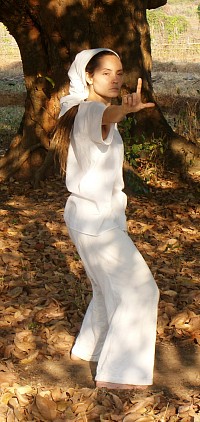
Do In (Dao/Tao Yin)
Do-In is the oldest form of Qi Gong recorded by man.
'Do/Dao' refers to the physical movements which stimulate the internal flow of Qi in the body, guided by the strength of the mind
In/Yin' refers to the movement of Qi reaching all the body and creating a complete cycle, assisted by specific physical movements.
The emphasis is on body-mind harmony attained through postures and movements.
Benefits of Qi Gong & Do-In :
- grounding and circulating the Qi in the meridians (energy channels),
- strengthening the body,
- calming the mind,
- developing concentration.
These practices enhance the awareness and feeling of Qi flow in and around the body.
This increased sensitivity enables the therapist to actively work with Qi (energy) as a healing tool.
Yoga Sadhana
In Sanskrit the word 'yoga' literally means "yoke", or "the act of yoking or harnessing", pointing at either the act of binding to the goal, or binding in the sense of things that bind one, like attachments, a state of clinging or craving.
Dating back thousands of years, yoga is the oldest defined sadhana (spiritual practice) of self development.
The goal of yoga is purification of the mind:
- Cleansing the mind of unwholesome tendencies
- Directing the mind towards wholesome mental states,
- Becoming freed from suffering
- Attaining real contentment and wisdom.
The methods of traditional yoga sadhana include : ethical and moral disciplines (yama & nyama), physical postures (asana), breath control (pranayama) and meditation (dharana, dhyana, samadhi).
For the serious adept, the first stage in this process is the ethical training in morality, followed by or in parallel to the basic physical preparation of the body for the mental work that lies ahead.
Many people today associate the word 'yoga', typically called Hatha Yoga, with the physical practices of asana and pranayama, postures and breath control. This is slightly misleading as the physical techniques are only a small part of the whole practice of yoga.
The Benefits of Yoga Sadhana
- Yoga as a path for spiritual transformation
- Yoga as a tool for physical well-being
- relaxation - physical strength - flexibility - energy and vitality - stress-management and relief - hormonal balance - mental concentration and focus - general well-being, and more.
Yoga Asanas (Postures)
- create balance in the whole body
- develop strength and flexibility
- activate the endocrine gland system
- calm the nervous system
- re-align the musculoskeletal system
- energize the cardiovascular system
How to Practice
- Dynamic and repetitive movement generates internal heat (tapas) and stamina.
- Slow and deliberate positioning emphasizes whole body alignment.
- Conscious and controlled breath (pranayama) cleanses the lungs, oxygenates the blood, relaxes tension and relieves stress.
- Standing, sitting, laying down asanas for specific physical conditions.
It's all about 'how to do', not 'how much' !
In addition to being a physical practice that makes one feel good, the practice of yoga asana can be your gateway into a personal spiritual inquiry.
Anyone can begin practicing yoga asana, even if you don't think that you are flexible or strong. You will find the poses that suit and benefit you most and create your own routine practice. With time it will develop into your individual experience with yoga.
Integrated courses include the practice of yoga asana and pranayama, according to relevance to the study program.
Meditation (Dhyan)
The word meditation is derived from the Latin 'meditatio', from a verb 'meditari', meaning "to think, contemplate, devise, ponder". The term meditation was introduced to the west as a translation for Eastern spiritual practices, referred to as ' bhavana' and 'dhyāna' in Buddhism and Hinduism, which comes from the Sanskrit root 'dhyai', meaning 'to contemplate or meditate'.
Meditation refers to a set of practices in which the practitioner trains the mind or enters a self-induced and regulated mode of consciousness to realize benefit. It is an inwardly oriented, personal practice, which individuals do by themselves for developing mindfulness and concentration. The practitioner focuses on training the attention and awareness in order to bring mental processes under greater voluntary control and thereby foster general mental well-being and development of mental capacities and qualities such as calm, clarity, and concentration. All these characteristics are cultivated towards the attainment of a higher goal, which is the acquisition of wisdom which liberates the mind from all unwholesome mental states.
In yoga, or dhamma (dharma), two important mental qualities that arise from wholesome and proper meditative practice are:
- serenity, or tranquility (samatha) - which steadies, composes, unifies and concentrates the mind;
- insight (vipassana) - which enables one to see, explore and discern phenomena for what they actually are.
Through serenity one is able to suppress obscuring hindrances and, with the suppression of the hindrances, it is through the development of insight that one gains liberating wisdom.
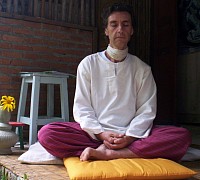
Benefits of Meditation
Throughout the day, we experience levels of stress which our bodies translate into reactions of tension, agitation, nervousness, moodiness, frustration, anger, impatience, etc. Prolonged or frequent stress periods may cause physical distress, ill-health and other physical and mental disorders. Meditation affects the body in exactly the opposite ways that stress does by -
- restoring the body to a calm state,
- assisting and supporting the body's mechanism of self-repair,
- preventing new damage due to the physical effects of stress.
Meditation can be effective as long as there is correct guidance and instruction. It does demand discipline and commitment to perfect the practice and attain results. Meditation can be the beginning of an individual process that can bring you to higher levels of awareness and states of profound and deep peace, where the mind is calm yet completely alert, aware and sharp, yet also equanimous. The culmination of this path of practice is the realization of ultimate truth and wisdom.
In general
- Qi Gong, Do-In, Yoga and Meditation are included in the courses of Knowing Touch, Zen Shiatsu, Wu Xing and Reiki, part of the daily schedule, separately or in combination. They are usually connected to the subject matter of the course as a supporting practice to the main course theme. Therefore, different exercises and practices are taught in each unit, by relevance and suitability.
All body-mind cultivation practices (qi gong, do-in, yoga, meditation) are taught wherever I am located, which in the past years is mostly in India (Goa), Thailand, as well as other parts of Asia, Israel and Europe. To see a current schedule click here.
- Some of these classes may be open also to external students who are interested in learning this practice only, without joining the main course.
- Any of the self-cultivation practices may be taught as an independent pre-scheduled course of 5-10 days, or upon request, with 1-2 practice sessions a day. A daily theory class about the philosophy, main concepts and elements of practice may also be included in the program.
- If you are interested in joining these classes (independent of a main course), or requesting a separate course, please contact regarding schedule and availability of places. Payment for these classes is based on a Sliding-Scale Donation Fee.

